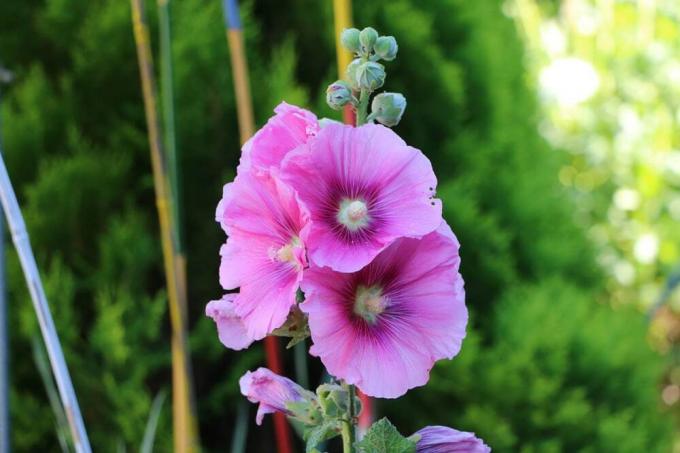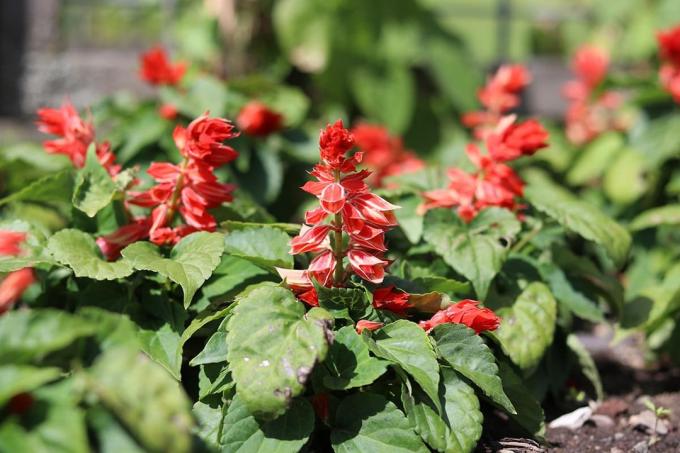

Table of contents
- Hollyhock disease: mallow rust
- Wilt on hollyhocks
- Protect hollyhocks against pests
- mallow flea
- mallow shrew
- snails
- aphids
- Conclusion
- Tips for speed readers
Originally, the Alcea (hollyhock) was native to the Orient. In Central Europe, they can be found in the wild in wastelands, near rubbish dumps or roadsides, but also as a garden and cultivated form.
Some of the approx. 60 species are very popular with home and hobby gardeners. It is a typical plant for the cottage garden.
Hollyhock disease: mallow rust
The hollyhock shows its many colorful flowers in late summer. Unfortunately, this summer splendor is often threatened by disease. The hollyhock is very susceptible to mallow rust and every garden lover should act quickly in this case. The plant disease is caused by a fungus (Puccinia malvearum). The damage, which begins as early as spring, can be recognized by the almost touching yellow to brown spots on the upper side of the leaves. An orange-red to brown rash later appears on the underside of the leaves. A typical sign are the holes in the leaves. Later the leaves die and fall off. Leaf stems and stems can also be affected.
At the beginning of the disease, the use of a spray mixture helps. In addition approx. Mix half a liter of compost in plenty of two liters of water. Let the porridge stand for a few days and stir every day. Filter the finished broth through a sieve and spray the plants and the soil with it every three to four days. Spraying is especially appropriate after the broth has been washed away after a downpour or new leaves have grown that have not yet been sprayed. Another spray liquid can be made from the plant parts of garlic, onion, field horsetail, sharp poison and tansy. Soak the plant parts for 24 hours, boil gently for 30 minutes and then pour through a sieve when cooled.
On the other hand, it is easier to use fungicides based on sulphur. The mushrooms thrive well on wet and heavy soil, so it is advisable to frequently loosen the soil around the hollyhock with a hoe and fertilize with potassium. Moist, dark corners of the garden promote the growth of fungi. Hollyhocks like an airy and sunny location anyway. If an infestation of fungi is found, a vigorous pruning of the affected parts also helps.
Digging up and discarding the entire plant is the right decision when all parts are infested and you don't want the spores to spread. These must then be burned immediately or disposed of in the rubbish bin. They must not be placed on the compost because other garden crops can also be attacked by mallow rust. This also applies to leaves that have already fallen off and are lying on the ground. Dispose of these as well, otherwise the fungus can overwinter on the leaves and infest the plant again next spring. To prevent fungal attack, a distance of at least 50 cm between the individual plants helps so that the air can pass through between them.
Wilt on hollyhocks

Another disease is wilt. Its cause is a disturbed water balance. The water vessels within the plant are destroyed by a fungus. The leaves begin to wither and then later fall off. The whole plant can be affected, including the stems. In the late stage, the entire plant dies. Once the disease has been identified, the plant and its roots should be generously dug up and destroyed along with the surrounding soil. In humid summers, an infestation by rust fungi can occur. The fungus does not damage the plant, but it is very unsightly due to red, yellow or dark brown rust pustules.
Protect hollyhocks against pests
The hollyhock is not only very popular with hobby gardeners, but also with voracious pests such as: snails, beetles, sawflies, spider mites, lice or caterpillars. If they are still rather rare, they are simply read off. The damaged and eaten leaves also removed. Otherwise, if the number of pests is large, it is necessary to use insecticides.
mallow flea
You can recognize the flea when the leaves have many small feeding holes in the middle and the leaf vein is intact. The beetle itself is blue, green, or black and has red legs. Countermeasure is loosening the soil and watering. A match stuck upside down in the ground can also help.
mallow shrew
The trademark of the beetle is its pointed snout and the feeding on the tips of the plant shoots. He lays his eggs in the stalks. The beetles are rather rare.
snails
Slugs and snails sometimes put a lot of strain on the hollyhock, especially by eating off the young leaves. The application of slug pellets or slug lentils in early spring provides a remedy.
aphids
A good remedy for aphids is nettle manure. To do this, chop up fresh nettle leaves and pour rainwater into a large container, place in the sun for a few days and stir daily. The finished liquid manure smells a bit unpleasant, but it is an effective bio-agent against the crawling creatures. It is used in a dilution of 1:10 and sprayed onto the plant in the morning. Another possibility is soapy water made with curd soap. Spray the insects with it and repeat several times, as not all of them will die the same way the first time.
Conclusion
The colorful and upright growing hollyhock should not be missing in any garden. It always fits as a background plant, on the fence in front of a house wall or even as a container plant. The offspring is not long in coming either. The seeds fall out of their dry pods almost by themselves. The plant is easy to care for, undemanding and surprises with an abundant and colorful willingness to flower. Planted together with white daisies and blue delphiniums, the hollyhock really comes into its own.
Tips for speed readers
Because of the long flowering period from summer to autumn, the hollyhock is a magnet for bumblebees and bees. Unfortunately, the hollyhock often suffers from mallow rust. This disease occurs especially in summer. Mallow rust is caused by a fungus called Puccinia malvearum. The infestation can be recognized initially - and that already in the spring - by yellowish-brown spots that are crowded together on the upper side of the leaf. On the underside of the leaf, on the other hand, you can see white pustules that later turn orange-red to brown. Severe infestations can cause the leaves to die and fall off. The petioles and stems can also be affected.
- The fight against mallow rust should already be taken up when planting the hollyhocks, because a lot can be done by prevention.
- Since the mallow rust is triggered by a fungus, which in turn prefers moist areas, the Plants are far enough apart that the air can circulate well and the leaves dry off better can.
- There are also preventive ones crop protection products, which are regularly applied to both the upper and lower sides of the leaves.
- If you still find infected leaves on the plant, these must be removed immediately and either burned or disposed of with household waste.
- Under no circumstances should the leaves remain in the garden, because not only the hollyhocks can be attacked by mallow rust, but also other garden plants.
- Another effective method of prevention is to cut the perennials just above the ground immediately after they have finished flowering.
- A small amount of soil should then be piled up around the plant to protect it. This will be removed again in the spring. The first 4 to 6 leaves should then be destroyed.
- If an infestation has occurred despite all preventive measures, there are chemical agents to destroy the fungus. An ecological approach is to remove and destroy the affected leaves.
Another disease that can affect hollyhocks is wilt. This is also triggered by fungi. Depending on the type of fungus, different parts of the plant are affected. The water vessels within the plant are destroyed by the pathogen. In most cases, the plant dies. If a plant is affected by the wilt disease, you should dig up the entire plant and the soil surrounding it and destroy it completely.
snails, Beetle, sawflies and caterpillars can also be enthusiastic about the hollyhock. With a small infestation, the plant pests simply be collected. If leaves have already been damaged, these are also removed. However, if the infestation has already gotten the upper hand, often only the use of one brings insecticide the desired success.
 garden editorial
garden editorial I write about everything that interests me in my garden.
Learn more about perennials

20 hardy plants that bloom all year round
With plants that flower all year round, you can quickly create an attractive garden that does not require much maintenance, as long as the plants are also hardy. In this post, we will introduce you to 20 plants that are suitable for this.

17 flowering hardy plants May to October
Many plants only show their full splendor for a short time. But there are also types and varieties with a particularly long flowering period from May to October, sometimes even longer. We present 17 flowering hardy plants.

Hardy perennials: 22 perennial bloomers
Hardy perennials as permanent bloomers in the flower bed enchant the garden from early summer to autumn with a colorful bloom. They are easy to care for and magically attract butterflies, bees and the like.

10 care tips for the banana tree
If you like it exotic, cultivate a banana tree as a houseplant or in the conservatory. In summer, the banana plants are even allowed outside for a few weeks. The large leaves that the Musa forms on a false trunk are particularly decorative and impressive, and therefore look like a small tree.

Properly care for globe thistle | 10 tips for care
The globe thistle is an eye-catcher in the garden. Their spherical flowers provide a food source for insects. The globe thistle is not difficult to care for and it is suitable for dry locations. With a few tips on care, the plants will develop even better.

Fire sage, Salvia splendens: care from A to Z
Fire sage is known in botanical jargon as Salvia splendens and is a particularly decorative eye-catcher. But what kind of care does the plant need? Our guide to the salvia shows the important points from A to Z.


